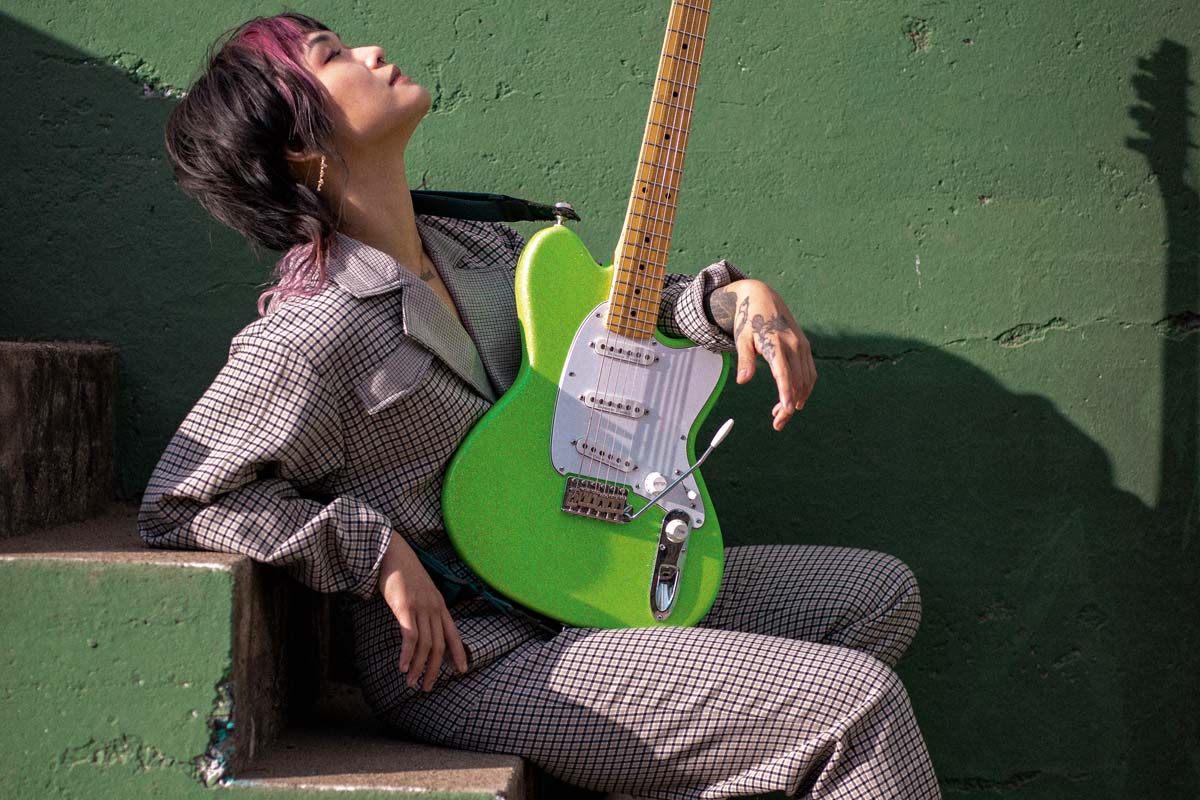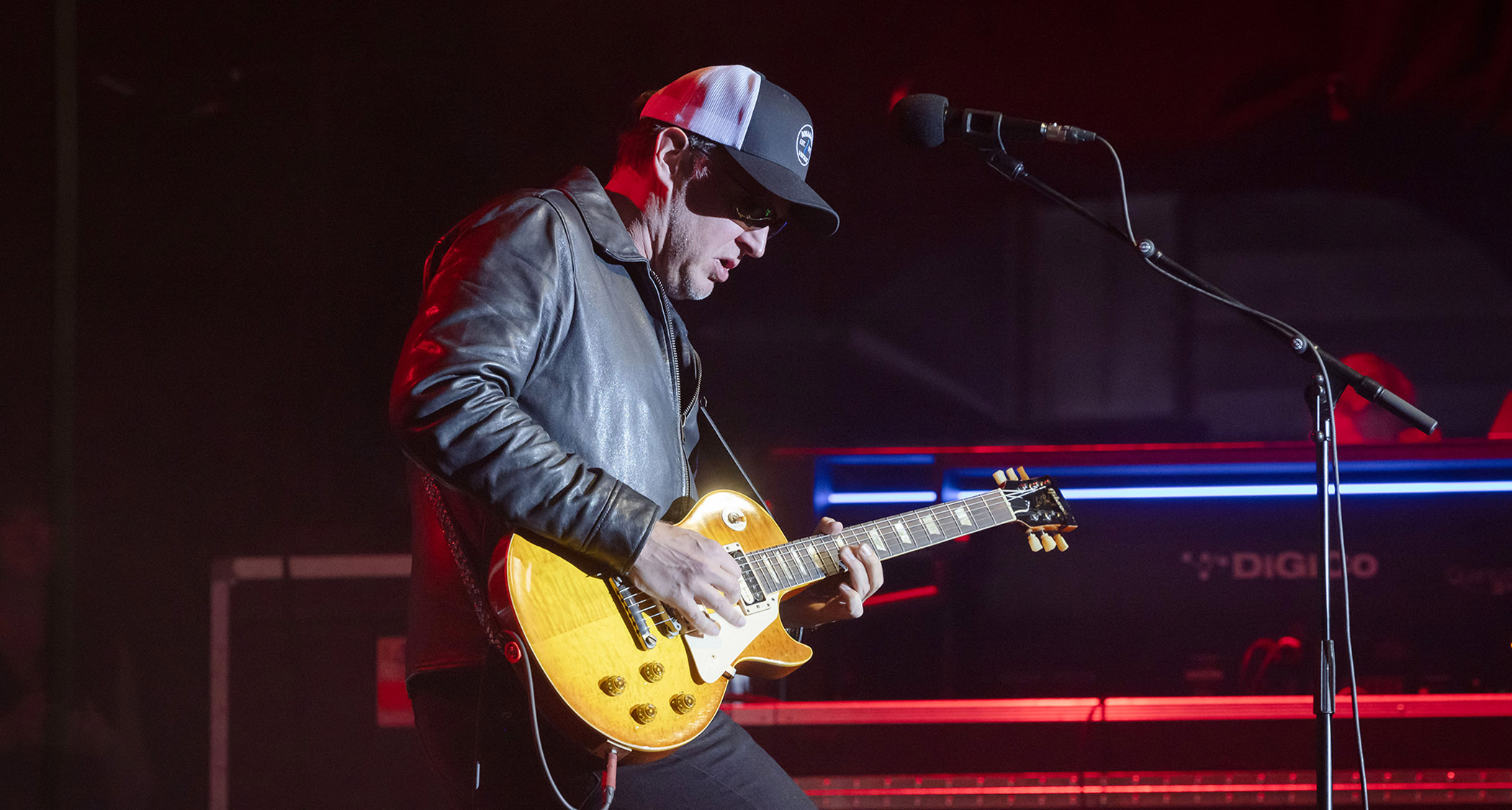Yvette Young: “I never really felt like I got good on guitar. The way I spend my time is still very much based around improving”
One of the most gifted and innovative guitarists of the modern era explains how she developed her unique style – and how you can find yours

The last few years have witnessed the rise of some truly astonishing guitar talents from around the world – each striving to carve out their own identity through the instrument, in the hope of telling stories that have never been told. Few, however, have felt as exciting as Yvette Young.
The Californian Ibanez endorsee and founding member of Covet is someone who plays by her own rules, using alternate tunings, fingerpicking, two-handed approaches as core fundamentals to bring out the ethereal and progressive sounds in her mind.
Having started out on classical piano and violin and later taken heavy influence from the more ambient soundscapes of shoegaze, she once jokingly described her genre as “detail rock”, though in all fairness it’s a term that fits quite spectacularly.
In this conversation with Total Guitar, she looks back on her journey so far – the main challenges starting out, the secrets behind her most complex passages, tips for the pedalboard and what the future may hold for her own sonic evolution...
When I think about the term ‘good guitar’ I end up thinking about total virtuosic shredding. I admire that stuff a lot but I can’t do a lot of the things all these monster players do.
When you were starting to get more creative with guitar, what felt like the biggest hurdles?
“This is so funny, but I never really felt like I got good on guitar. The way I spend my time is still very much based around improving. When I think about the term ‘good guitar’ I end up thinking about total virtuosic shredding. I admire that stuff a lot but I can’t do a lot of the things all these monster players do.
“When I think about getting, it’s more about getting faster at conveying what I hear in my head and translating it to the fretboard. For me, that’s when I feel like I’m good at guitar... When I can translate that vision instantaneously rather than sit around and dick around for a bunch of time!”
All the latest guitar news, interviews, lessons, reviews, deals and more, direct to your inbox!
Is there anything you stumbled on that helped speed up that process?
“Well, it all comes down to experience. I could view that question a bunch of ways. For example, with my tone it came down to playing around with lots of gear and getting to know the nuances of different pedals, amps or simulators. So tonally, that will come from spending more time with my toys and amp. It’s good to know how each knob will affect your tone.
Playing in so many different tunings, rather than sticking to standard, made it difficult for me to memorise shapes because I’m constantly changing the notes of each string
“In terms of melody, translating those melodies from my mind to the instrument – that came from a lot of ear training. And my classical background played a big part there. I also think playing in so many different tunings, rather than sticking to standard, made it difficult for me to memorise shapes because I’m constantly changing the notes of each string. But it comes with time... The more I get used to every tuning, the quicker I get at remembering where certain intervals are.”
Then, of course, there’s a lot to be said for humming and singing notes as you play them...
“Yeah, one hundred per cent! That’s how I write everything, I sing it first and that way I’m not letting convenience or habit dictate what I write. Instead, I’m writing intuitively with my voice and sense of melody. I feel like if you get good and stick to the shapes you know, stuff starts sounding the same. I prefer to sing and find the chords and melodies on the fretboard after.”
Do you remember the first time you tuned differently and how you got around the challenges presented in doing that?
“I think the first time I did that was to learn a song by the Japanese band Toe. It was the song Two Moons that I was trying to learn. I found out they were using a different tuning, which to my ears sounded like FACGBE... Thank you, ear training! And yeah, I just did it all by ear. I just sang each note until I found it. So that was my first experience and from then on I started understand the tuning more and finding my own melodies.”
As for the more intricate aspects of your style, what would you say are the main challenges on the technique side?
“I think the most daunting thing is thinking about music totally polyphonically, which is when I’m doing the more elaborate tapping and fingerstyle stuff. There are so many voicings within them. Sometimes when I go from really chugging chords to hearing that, even I’m wondering how the hell to play it all at once.
“The answer is always breaking it down into little digestible parts. Because people always ask me how I write and memorise phrases that are not only intricate and long but also in compound time with meters that aren’t in straight 4/4. That’s a lot of stuff to think about while you play! And what works for me is breaking it all down into little pieces, even if it means going note by note and then stringing it all together.
Maybe for other guitarists it’s more improvisational or simpler chord structures, but with my stuff you can’t do it all at once. It’s one step at a time and then linking it all up at the end
“That’s still my process to this day. It’s like I just pick up the guitar and immediately play long phrases. Every part is really thought-out and deliberate. Maybe for other guitarists it’s more improvisational or simpler chord structures, but with my stuff you can’t do it all at once. It’s one step at a time and then linking it all up at the end.”

You have so many different licks under your belt, of course, but if there was one signature Yvette Young lick, what would it be?
“I guess the lick I’m most known for is the one in my song Shibuya. It’s that tapping part – and when I wrote it, I had no idea it would become one of my most popular pieces. For starters, you have to tune to D A D F# A E with a capo on the second fret.
“The best tip I can offer for learning that is getting used to fingerpicking on the fretboard, rather than where your pickups are. That’s because when you combine fingerpicking and tapping you don’t want to travel the extra distance, with your picking hand jumping back and forth.
“You need to get used to it being one fluid motion and basing your picking hand around the 12th fret. A lot of my stuff is combining two-handed tapping with fingerpicking and chords. It’s like combo-moves all the way [laughs]!”
Though you play through a low-watt British valve combo, your sounds are incredibly expansive and experimental. What advice could you offer someone setting up their first pedalboard to explore time and space Yvette Young-style?
“Ooh, that’s a great question! I would say a lot of the breakup you can actually get by playing with a compressor and pushing the tubes. It depends what kind of amp you have, but if you’re using a Vox AC30 or AC10 like me, a compressor can really help a lot.
“I use The Warden by EarthQuaker and the sustain can really help with overdriven sounds by pushing your clean tone. Then I would say you need a chorus pedal, for sure. I use the Walrus Julia – they just came out with a stereo version called the Julianna, which is amazing as well. For the newer stuff that I’ve been writing for the next record, it’s all been chorus-drenched [laughs]!
Delays are cool because you can actually use them a bit like a reverb, they can multi-task to some extent
“Let’s see, perhaps after that you’d want a nice delay for stereo-sounding passages. I use the EarthQuaker Avalanche Run or my personal favourite which is the MXR Carbon Copy Deluxe, always running in the loop. But I have to say, for future stuff with the stereo rig I’m currently working on, I might actually play around with where things go in the chain.
“Delays are cool because you can actually use them a bit like a reverb, they can multi-task to some extent. As a final recommendation, maybe something like the MXR Bass Octave Deluxe. I used that a lot to add girth and weight to certain sections, it’s a really fun pedal.
“Actually, maybe instead of that – a lot of people know me for a really warbly lo-fi sound, so I have to mention the Caroline Guitar Somersault Modulator or the Z.Vex Lo-Fi Junky, which I think is great for making your guitar sound like old tape.”
So when a new pedal arrives, what exactly are the first things you do with it?
“I’m pretty intuitive in that way; I sit around and explore first and worry about what it sounds like later. I’ll open a new pedal and just go for it, maxing out every dial and isolating each one so I know exactly what it does. You want to know how each parameter works in isolation but also how they interact with each other.
“Eventually I find a couple of settings that are very musical and usable, things that will inspire me. Honestly, sometimes I hear a tone and the melody comes immediately because the sound is so colourful, rich and inspiring. To me a great tone feels like a story waiting to be told... I know that sounds really cheesy!
“Sometimes I plug into gear and a song just happens. That actually happens about 70 per cent of the time. I might plan to play around with it but instead I ended up writing songs! If I want a challenge, I might actually look for a setting that I find cacophonous and unusable and then try to turn it into something melodic.”
Speaking of which, how much do you think about music theory when composing or improvising?
“Although I grew up with theory, I hardly ever think about it. I don’t really think about modes or anything because it’s so intuitive. This goes back to the ear training – it’s all there to help you get sounds out of your head and into the real world.
“In my childhood, I spent a lot of time studying different types of music and understanding how different notes relate to each other, identifying those intervals and learning the rules of harmony and dissonance. So it was the ear training specifically that benefitted me the most.
“Oh, and being exposed to music that was more freeform in meter rather than 4/4 like a lot of pop music. That’s where it all grew from. If you expose yourself to different things, it will naturally come out. Get really good at knowing the intervals in your head before you’ve even played them.
“And having a long musical memory really helps too, because I can store those phrases in my head without having to constantly refresh. If you want to build up the strength of your ear, instead of looking up tabs try to do everything by ear! See if you can actually hear it.”

What kind of ear training exercises helped – did you ever try using one of the apps?
“I never had an app but I did have this scary Russian person screaming at me [laughs]! So get yourself a teacher who terrifies you and then every time you get the interval wrong, you’ll get a slap on the wrist! I’m just kidding. I went to a music academy where I would get tested every day and have to identify different intervals and scales.
“I hope my conductor doesn’t read this, but even in the orchestra back in the day, somehow I finessed my way into being concert master on violin and I literally didn’t practice a single note because I hated it! Then the day before the audition I would just listen to the song and memorise it that way.
“I didn’t read the music. I mean, I could, but I was really slow at reading and found my ear was way faster. I’m quite impatient. That helped me survive the orchestra years... Pretending I was reading but actually using my ear.”
Isn’t it cool how certain modes and scales are evocative of certain feelings? I’m so fascinated by it all. Why is one scale so universally depressing to everyone, and another one so tense?
A lot of musicians use reference moments to remember different intervals – Jaws and the minor 2nd being one classic example…
“For sure, and the same can be said with modes, and I’d use things I knew like The Simpsons theme to remember that was the sound of Lydian Dominant. Having reference points like that really helps, that’s how I knew different songs in different keys would have the same sound even if it’s in a different context.
“People use the same themes and motifs constantly, they just find clever ways to re-contextualise things. Isn’t it cool how certain modes and scales are evocative of certain feelings? I’m so fascinated by it all. Why is one scale so universally depressing to everyone, and another one so tense or another one sounding so outer space? It’s funny how certain intervals hit everyone in the same way.”
How would you explain tapping to someone who’s never tried it before?
“The first thing I would say is check your gear. A lot of people who ask me about tapping always wonder why my tone is so strong and good, while they find it sounds weak and sh*tty when they try it.
I always recommend lowering the action while also getting some heavier gauge strings. I used to play 13s because I’m a psycho, but now I’m back at 12
“Quite often, the action will be too high and they’ll be playing really thin strings like nines. So I always recommend lowering the action while also getting some heavier gauge strings. At first it will feel uncomfortable. I used to play 13s because I’m a psycho, but now I’m back at 12.
“I would say 11 is a perfect gauge for people who still need to bend and fingerpick as well as tap. Because of my piano background, I do this intuitively, but I feel like the way you hit the strings is important, the lift-off is just as important as when you tap down. It’s like pressing a button down really quickly but gingerly lifting off so the decay of the note still sounds smooth. You need to do it at the exact right time so you don’t mute your own tap.
“It’s kinda tricky to explain, but also try tapping within each fret to find out where you get the best tone. I tend to find it’s the upper half, closer to the next fret. Check to see when you lift up what is still ringing out, if there are any overtones or noises. You need to get used to that motion and strengthening every finger – you want them all to sound nice and even.”
Open strings are cool because you can use them to harmonise automatically in key to whatever you are playing
Tuning to obscure chords also frees up more open strings, which can often catch the listener off-guard and, in your case, add to the progressive charm...
“Definitely. I also sometimes tune pairs of strings as an octave, so you have this constant drone. Open strings are cool because you can use them to harmonise automatically in key to whatever you are playing. The same goes for capos, they can help diversify your palette.”
What would you like to accomplish as a guitar player over the next five years?
“I guess I hope to become even quicker at translating my ideas from my head to the guitar. That will only come from practising. You need to spend a lot of time with it to get there... I don’t feel like I’m there yet. I’d also like to get more comfortable with jamming with all kinds of musicians, because right now I’m such a private person when I compose.
“There isn’t anything necessarily wrong with that, when I write I have to be in my own headspace. I can’t have any other energy there, pulling my brain in a different direction. It’s truly meditative. But that said, I’d like to get more comfortable around others and more open in my process, allowing myself to vibe off someone else’s energy. Jamming might not be the best way for me to write, but I’d still like to improve there. It’s just another skill, right?!”
So what do you think the next Covet record will sound like?
“I was actually thinking about that just the other day. I definitely haven’t put out my best material and I’m sat on a load of new songs that I’m really excited about – I hope that feeling stays. I want it all to come out in the best way possible. I’ve been writing a lot during quarantine. Whatever I put out next will be even more intentional and musically stronger as a result.”
You’ve got to find your own sound. You’ll know when you do, because when you play, you will feel something very special
Finally, what would you say is the one thing every guitarist should avoid?
“It’s almost paradoxical. The way I write and my general style is all based on things that excite me but don’t sound like anyone else. So you have to figure out what excites you. Of course, learn other people’s styles but at the end of the day don’t try to be anyone else. Take that information but carve your own path.
“You’ve got to find your own sound. You’ll know when you do, because when you play, you will feel something very special. That’s how I know I’m doing something right – when I literally start glowing from the way it makes me feel.”
- Covet's latest album, Technicolor, is out now via Triple Crown Records Inc.
Amit has been writing for titles like Total Guitar, MusicRadar and Guitar World for over a decade and counts Richie Kotzen, Guthrie Govan and Jeff Beck among his primary influences as a guitar player. He's worked for magazines like Kerrang!, Metal Hammer, Classic Rock, Prog, Record Collector, Planet Rock, Rhythm and Bass Player, as well as newspapers like Metro and The Independent, interviewing everyone from Ozzy Osbourne and Lemmy to Slash and Jimmy Page, and once even traded solos with a member of Slayer on a track released internationally. As a session guitarist, he's played alongside members of Judas Priest and Uriah Heep in London ensemble Metalworks, as well as handled lead guitars for legends like Glen Matlock (Sex Pistols, The Faces) and Stu Hamm (Steve Vai, Joe Satriani, G3).

